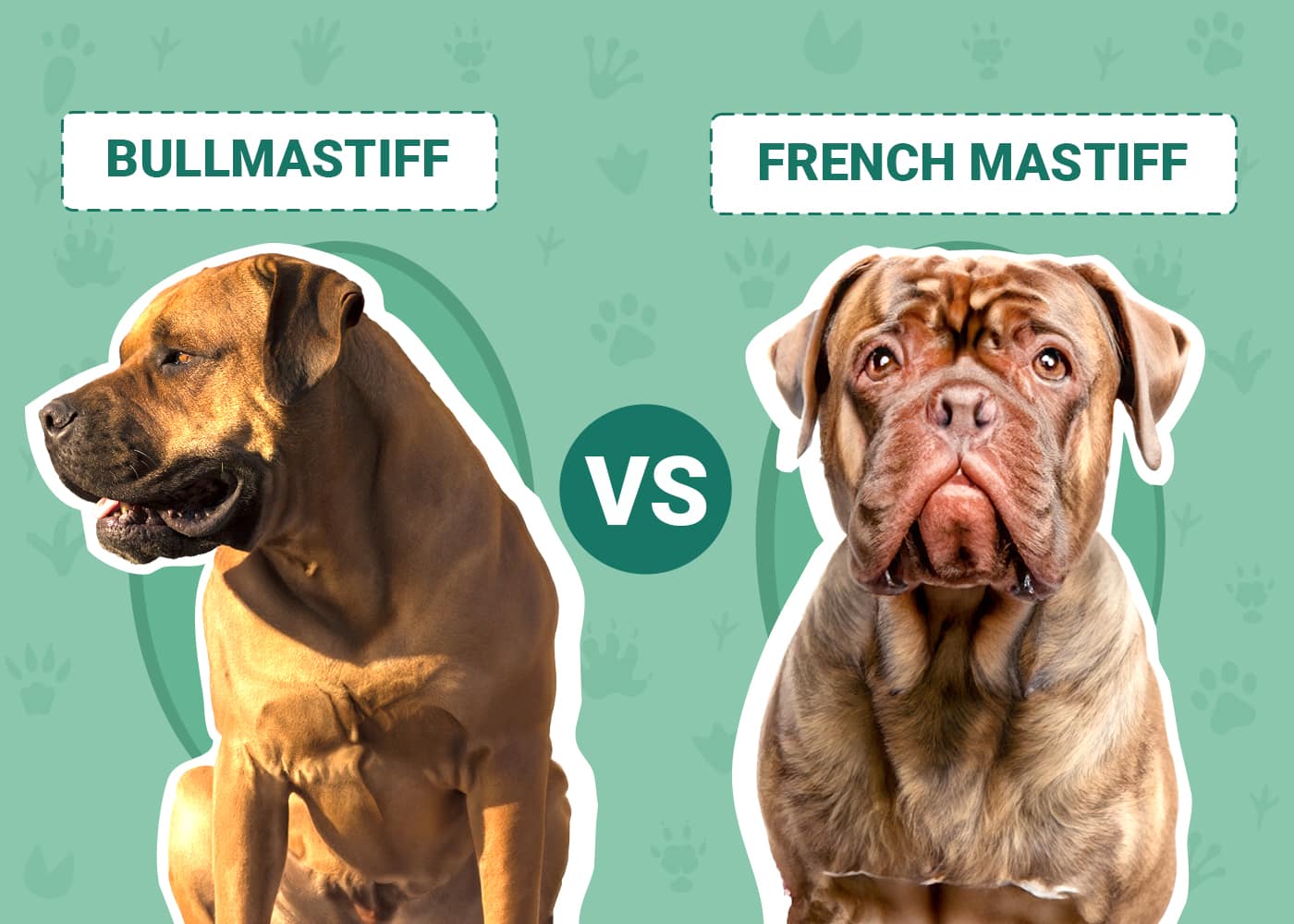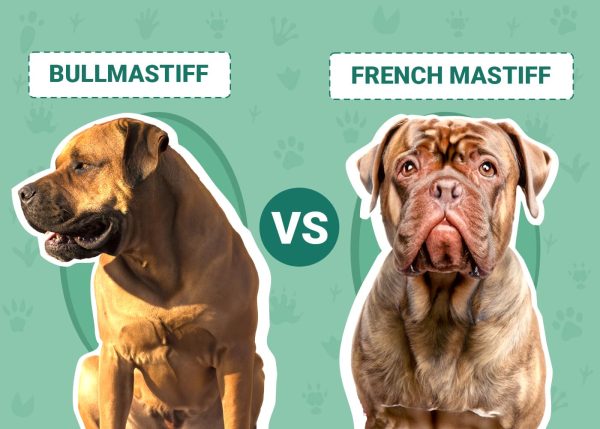Click to Skip Ahead
If you like big dogs, then you likely already know about Mastiffs. There are multiple breeds that fall into the Mastiff category, but all are very large dogs. If you’re in the market for a big dog and you’ve been looking at Mastiffs, then you may be struggling to narrow down which breed is right for you.
To help you out, here’s a comparison of two of the Mastiff breeds: the Bullmastiff and the French Mastiff, also known as the Dogue de Bordeaux. While these giant breeds share some similarities, they are quite different from each other. Learning the differences between the two can help ensure you end up with the breed that is best suited to your home and lifestyle.
Visual Differences
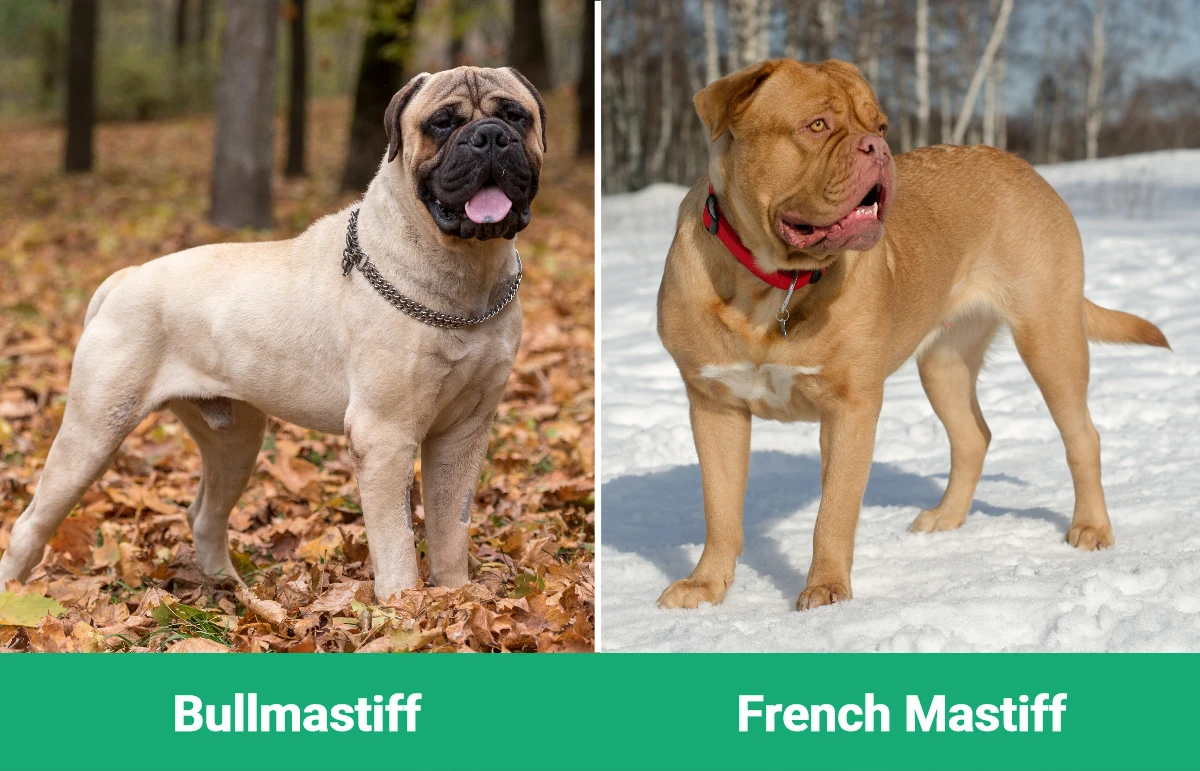
At a Glance
- Average height (adult): 24–27 inches
- Average weight (adult): 100–130 pounds
- Lifespan: 7–9 years
- Exercise: 2+ hours a day
- Grooming needs: Low
- Family-friendly: Often
- Other pet-friendly: Often
- Trainability: Calm, engaged, strong-willed
- Average height (adult): 23–27 inches
- Average weight (adult): 99–100+ pounds
- Lifespan: 5–8 years
- Exercise: 1+ hours a day
- Grooming needs: Low
- Family-friendly: Often
- Other pet-friendly: Often
- Trainability: Relaxed, independent, strong-willed
Bullmastiff Overview

Temperament
The Bullmastiff is a loyal dog with a protective nature. They are brave dogs that show no fear in the face of danger, making them excellent watchdogs and guard dogs. They tend to be quite loving and engaged with their human family, but their tolerance of children and other animals is highly dependent on each individual dog.
Early socialization can help drive success with this, though. There is also a chance that your Bullmastiff won’t be accepting of strangers, especially noisy people and energetic children, so make sure you’re familiar with your dog’s level of acceptance.
Exercise
Although often viewed as a big, lazy dog, the Bullmastiff actually requires a decent amount of exercise every day. Energy levels vary between dogs, and you may end up with a dog that wants to spend all of its time being a couch potato. Regardless of how much exercise your dog wants to get, it’s important that you aim to get around 2 hours of exercise every day. Exercise will help maintain a healthy body weight, as well as supporting joint health.
Just remember that Bullmastiffs are very large dogs, so if they decide to sit down and not move, you will have trouble getting them back up again.

Training
Even though Bullmastiffs are known for their love of their families, these dogs can be extremely strong-willed and stubborn. These undesirable traits are often more pronounced in dogs that were not socialized properly and that did not have training when very young.
You should begin work on basic obedience skills as soon as you bring your Bullmastiff puppy home. These dogs are more intelligent than you might realize, so make sure not to let your dog’s stubbornness rule the training sessions.
Health & Care❤️
Due to their extremely large, heavy frame, Bullmastiffs are prone to developing joint problems, like hip and elbow dysplasia. Maintaining a healthy body weight can reduce the risk of this occurring, but responsible breeding is also essential. This breed is also at risk for heart problems, hypothyroidism, and eye problems, as well as certain cancers.
The prevalence of these conditions can be reduced through responsible breeding and appropriate health testing, but not completely prevented. Like all giant breeds, the Bullmastiff is at risk for bloat, which is a medical emergency.
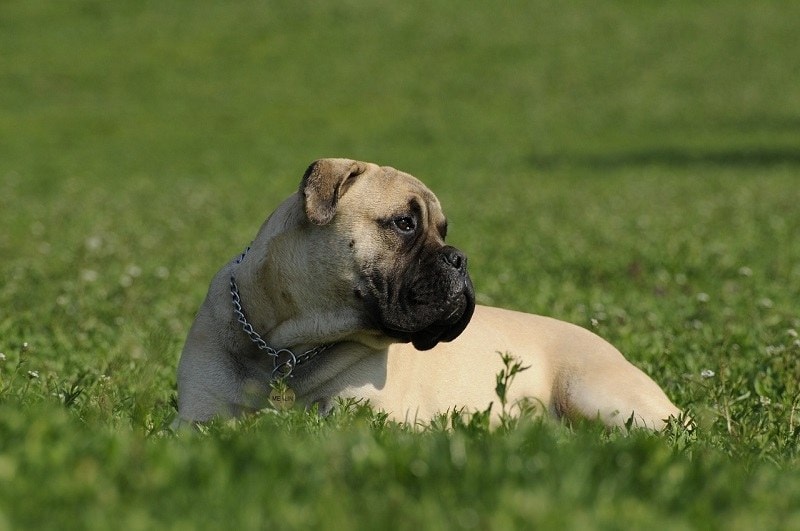
Suitable For:
While some Bullmastiffs are comfortable with children, not all of them are, so choosing this dog as a family pet should be done with care. They are extremely loyal and protective dogs, making them a great option for guarding and protecting.
Their energy levels are highly variable, but most Bullmastiffs are unlikely to be willing to go for daily runs or hikes, so they are often great pets for moderate-activity households.
French Mastiff Overview
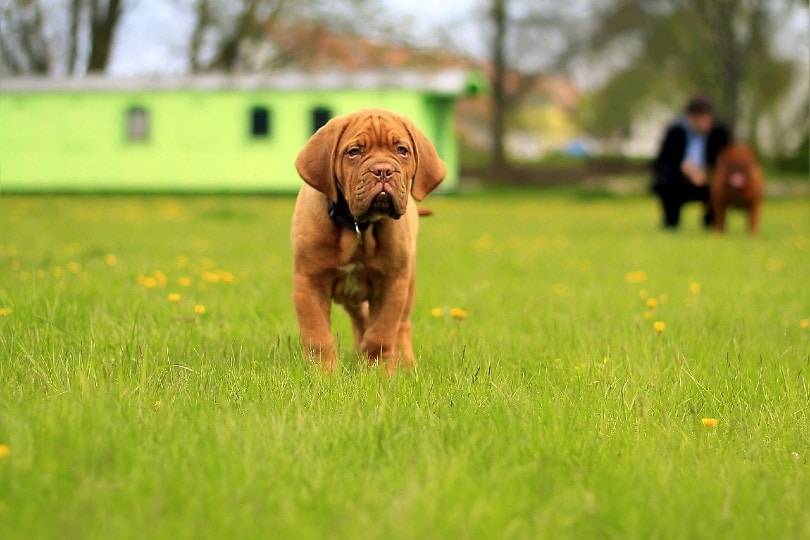
Temperament
Much like the Bullmastiff, the French Mastiff tends to be quite affectionate toward its human family but may have a low tolerance for children and other animals. They are calm, relaxed dogs that are likely to be more independent than the Bullmastiff.
They may be sensitive, so loud people and environments may make them nervous. They are protective, brave, confident, and loyal, but they may be aloof with strangers.
Exercise
The French Mastiff doesn’t require a lot of exercise, with most dogs being happy with about an hour of exercise daily. In general, a couple of walks are enough activity, but some dogs may want to participate in more high-energy activities.
While these big dogs may move slowly and seem to lumber most of the time, they are actually quite athletic, and once something activates their interest, you can expect your French Mastiff to move very quickly.
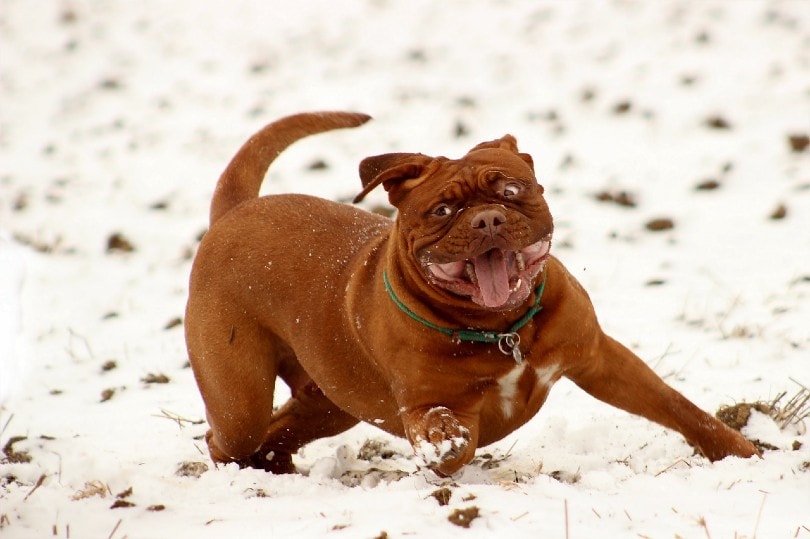
Training
Like most Mastiffs, the French Mastiff has a stubborn streak that can be difficult to work with. Early socialization and training initiation are very important to helping your dog grow into an obedient adult. Because they are somewhat sensitive, they are unlikely to respond to negative training methods, so stick to positive reinforcement and other positive training methods with the French Mastiff.
Health & Care❤️
As with the Bullmastiff, the French Mastiff is quite prone to joint problems. Responsible breeding practices, regular exercise, and a healthy body weight can reduce the risk of problems developing. This breed is also prone to developing epilepsy, and dogs with epilepsy should not be bred.
Heart disease and certain cancers can occur in this breed as well. Bloat is a serious concern for the French Mastiff.

Suitable For:
This breed is loving and affectionate toward its people but may not be tolerant of children and other animals, so be careful when choosing a French Mastiff as a family pet. With proper socialization and training, they are likely to make great family dogs, though. They are great for protection and guarding work.
They love spending time with people, but they’re also relatively independent dogs, making this breed a good option for someone who doesn’t want a Velcro dog.
What Is a Mastiff?
Since there are multiple dog breeds that fall under the “Mastiff” umbrella, it can be confusing. What traits actually make these dogs all fall into the same category, even though they’re different breeds?
Interestingly, the location that a breed originated from doesn’t have any bearing on its ability to be classified as a Mastiff, as Mastiff breeds have come from at least four continents. Mastiffs are large, powerfully built dogs that have brachycephalic faces, which means they have a shortened muzzle and a flat-faced appearance. They are short-haired dogs with a low-set tail, large paws, drooping ears, and a large, often boxy skull.
Mastiffs have existed in some form for at least 3,000 years, and they have been used for similar purposes throughout. Protection and guarding have been top jobs for them, but they have also been used as war dogs, fighting dogs, large animal baiting dogs, and hunting dogs for large game. In some old texts, Mastiffs are interchangeably referred to as “bandogs”.
While some breeds carry the Mastiff name, like the Tibetan Mastiff, Spanish Mastiff, and Pyrenean Mastiff, they are not considered true Mastiffs. These breeds were developed as livestock guardians, not as fighting or general guard dogs. You may see them grouped together with Mastiffs under the umbrella categorization of molosser dogs.
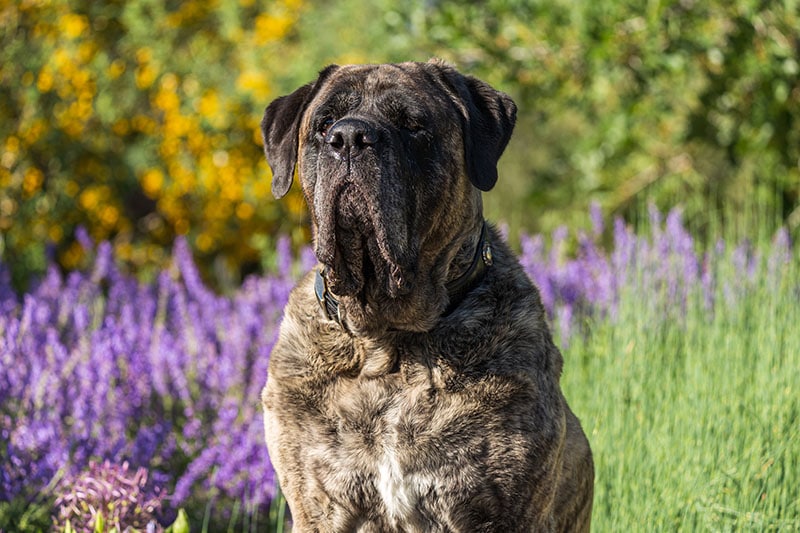
Which Breed Is Right for You?
If you’re looking for a family dog, then you may find the Bullmastiff and French Mastiff to not be suitable, but if you get a young puppy, you will have the opportunity to socialize your dog to help them be more accepting of children and other animals. Both breeds are quite stubborn, but the French Mastiff tends to be more sensitive than the Bullmastiff, making harsh training methods ineffective.
The Bullmastiff is likely to want to be with you whenever you’re around, while the French Mastiff tends to be a little more independent. Both breeds are confident dogs that make great guard dogs and protection dogs. The French Mastiff has a shorter average lifespan than the Bullmastiff. Both breeds have similar health risks, especially when it comes to joint problems, but the French Mastiff is more likely to develop epilepsy than the Bullmastiff.
Bullmastiffs often do better with at least two hours of exercise daily, while the French Mastiff is likely to be happy with just one hour of exercise. Neither breed is likely to enjoy high-energy activities, like running, but this can vary greatly between individual dogs.
See also:
- Bullmastiff vs. English Mastiff: Differences Explained
- Caucasian Shepherd vs Tibetan Mastiff: The Differences (with Pictures)
Featured Image Credit: Top – Olga Raduzhnaya, Shutterstock | Bottom – David Charles Cottam, Shutterstock

